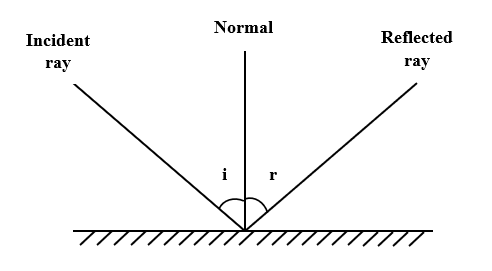
State the laws of reflection.
Answer
552.9k+ views
Hint: Reflection is the phenomenon of bouncing back of light by an object. To answer this question, consider a light incident upon the surface present in the same medium and gets reflected back. The light ray gets reflected from the same plane on which the light is incident. There is another law related to the angle of incidence and angle of reflection. This information can be used to state the two laws of reflection.
Complete answer:

When a light ray is reflected from a surface, it obeys specific laws. These laws are known as Laws of reflection. There are two laws of reflection which are as follows:
1. The first law of reflection states that the incident ray, reflected ray, angle of incidence (i), angle of reflection (r) and the point of incidence i.e. normal all lie on the same plane as shown in the above figure.
2. The second law of reflection states that the angle of incidence is equivalent to angle of reflection. If the incident ray falls on the plane of a mirror along the normal at 90°, then the reflected ray will travel along the same path.
Note:
The laws of reflection are valid to all the reflecting surfaces including spherical mirrors. Students must remember that changing the angle of incidence will also change the angle of reflection but both will still be in the same plane. The laws of reflection only hold true for reflection in the same medium, however if the medium is different there are separate laws governing this phenomenon. There are laws of refraction as well. So, students must not get confused between laws of reflection and laws of refraction.
Complete answer:

When a light ray is reflected from a surface, it obeys specific laws. These laws are known as Laws of reflection. There are two laws of reflection which are as follows:
1. The first law of reflection states that the incident ray, reflected ray, angle of incidence (i), angle of reflection (r) and the point of incidence i.e. normal all lie on the same plane as shown in the above figure.
2. The second law of reflection states that the angle of incidence is equivalent to angle of reflection. If the incident ray falls on the plane of a mirror along the normal at 90°, then the reflected ray will travel along the same path.
Note:
The laws of reflection are valid to all the reflecting surfaces including spherical mirrors. Students must remember that changing the angle of incidence will also change the angle of reflection but both will still be in the same plane. The laws of reflection only hold true for reflection in the same medium, however if the medium is different there are separate laws governing this phenomenon. There are laws of refraction as well. So, students must not get confused between laws of reflection and laws of refraction.
Recently Updated Pages
Why is there a time difference of about 5 hours between class 10 social science CBSE

In cricket, what is a "pink ball" primarily used for?

In cricket, what is the "new ball" phase?

In cricket, what is a "death over"?

What is the "Powerplay" in T20 cricket?

In cricket, what is a "super over"?

Trending doubts
What are the major means of transport Explain each class 12 social science CBSE

Which are the Top 10 Largest Countries of the World?

Draw a labelled sketch of the human eye class 12 physics CBSE

How much time does it take to bleed after eating p class 12 biology CBSE

Explain sex determination in humans with line diag class 12 biology CBSE

Explain sex determination in humans with the help of class 12 biology CBSE




